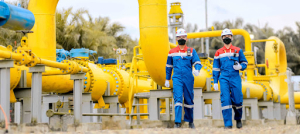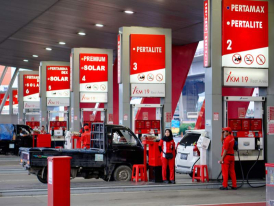Pertamina Group prepares bioethanol ecosystem, a drive for energy transition
The transportation sector is one of the largest contributors to greenhouse gas emissions in Indonesia that the use of environmentally friendly fuel oil, including those mixed with bioethanol, is one of the best solutions to reduce the emissions.
Risk Management Director of Pertamina New & Renewable Energy (Pertamina NRE), Iin Febrian, said that Indonesia has been successful with B35, a blend of palm oil-based biofuel, fatty acid methyl esters (FAME), at 35 percent.
Late last year, PT Pertamina Patra Niaga launched Pertamax Green 95, a Pertamax fuel with a 5-percent bioethanol blend. The government is now encouraging bioethanol utilization as a mixture for gasoline-type fuels in accordance with Presidential Regulation No. 40/2023 on the Acceleration of National Sugar Self-Sufficiency and the Provision of Bioethanol as Biofuel.
Addressing a panel discussion at the Green Initiative Conference organized by Kumparan on September 25, 2024, Iin said that not only does it support Indonesia's enhanced nationally determined contribution (ENDC) target, the development of bioethanol as biofuel also has the potential to create great value.
“From developing raw materials, such as sugar cane, corn, sorghum, and other types of plants, to distributing them to the public, the development of bioethanol can create great value, one of which is opening up wider employment opportunities,” he said.
Bioethanol plant
Pertamina NRE is mandated by its parent company, PT Pertamina, to develop the bioethanol business as a raw material for Pertamax Green. Pertamina NRE has a short, medium and long term strategy starting from 2024 to 2035 in the development of bioethanol.
“As part of the short-term strategy, we have signed an agreement with PT Sinergi Gula Nusantara to build a new bioethanol plant with molasses as raw material in Glenmore, Banyuwangi, with a capacity of 30 thousand kiloliters per year,” Iin said.
The current national ethanol production capacity reaches around 180 thousand kiloliters per year, while the need for 5-percent ethanol (E5) currently reaches 1.9 million kiloliters per year and will double if E10 is implemented. In the short to long term, Pertamina NRE will still target the construction of new bioethanol plants in the hope of minimizing the gap between supply and national demand.
The soil in Indonesia has the potential to be planted with several types of energy crops that have the potential to become bioethanol feedstock. By diversifying the types of raw materials, it is expected that it will not interfere with the national sugarcane demand for food.
Pertamina is currently conducting studies to develop several bioethanol feedstocks other than sugarcane, including sorghum, nipah (Nypa fruticans), and oil palm empty fruit bunch.
Pertamina NRE is strongly committed to developing clean energy as a form of support for the energy transition to achieve the government's aspiration of net zero emission by 2060.
Pertamina Vice President for Corporate Communication, Fadjar Djoko Santoso, said Indonesia has great potential for bioethanol development so that it can become one of the renewable energy solutions.
“Bioethanol is produced from organic materials that offer great potential for a cleaner and more sustainable energy future,” Fadjar said.
Already have an account? Sign In
-
Start reading
Freemium
-
Monthly Subscription
30% OFF$26.03
$37.19/MonthCancel anytime
This offer is open to all new subscribers!
Subscribe now -
Yearly Subscription
33% OFF$228.13
$340.5/YearCancel anytime
This offer is open to all new subscribers!
Subscribe now






